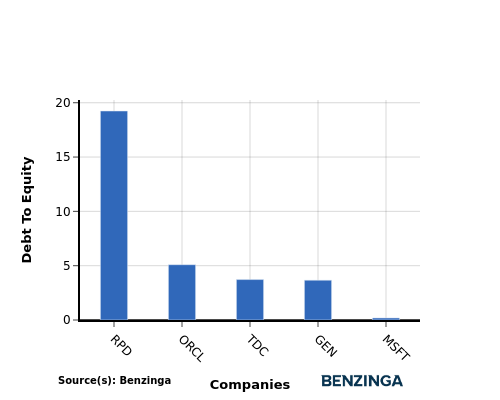Insights Into Microsoft's Performance Versus Peers In Software Sector
In today's rapidly changing and highly competitive business world, it is imperative for investors and industry observers to carefully assess companies before making investment choices. In this article, we will undertake a comprehensive industry comparison, evaluating Microsoft (NASDAQ:MSFT) vis-à-vis its key competitors in the Software industry. Through a detailed analysis of important financial indicators, market standing, and growth potential, our goal is to provide valuable insights and highlight company's performance in the industry.
Microsoft Background
Microsoft develops and licenses consumer and enterprise software. It is known for its Windows operating systems and Office productivity suite. The company is organized into three equally sized broad segments: productivity and business processes (legacy Microsoft Office, cloud-based Office 365, Exchange, SharePoint, Skype, LinkedIn, Dynamics), intelligence cloud (infrastructure- and platform-as-a-service offerings Azure, Windows Server OS, SQL Server), and more personal computing (Windows Client, Xbox, Bing search, display advertising, and Surface laptops, tablets, and desktops).
| Company | P/E | P/B | P/S | ROE | EBITDA (in billions) | Gross Profit (in billions) | Revenue Growth |
|---|---|---|---|---|---|---|---|
| Microsoft Corp | 39.42 | 11.78 | 14.11 | 8.27% | $40.71 | $48.15 | 13.27% |
| Oracle Corp | 56.12 | 33.45 | 12.16 | 18.43% | $6.83 | $11.16 | 11.31% |
| ServiceNow Inc | 130.25 | 19.61 | 17.48 | 4.66% | $0.72 | $2.44 | 18.63% |
| Palo Alto Networks Inc | 114.87 | 18.43 | 15.96 | 3.85% | $0.4 | $1.67 | 15.33% |
| Fortinet Inc | 44.01 | 41.70 | 13.47 | 25.08% | $0.56 | $1.25 | 13.77% |
| Gen Digital Inc | 29.41 | 8.28 | 4.80 | 6.43% | $0.53 | $0.81 | 4.77% |
| Monday.Com Ltd | 284.15 | 13.27 | 14.43 | 2.57% | $0.01 | $0.25 | 30.12% |
| CommVault Systems Inc | 100.43 | 23.11 | 7.66 | 10.11% | $0.03 | $0.23 | 23.17% |
| Dolby Laboratories Inc | 28.45 | 2.80 | 5.54 | 3.61% | $0.14 | $0.33 | 1.38% |
| Qualys Inc | 28.53 | 10.18 | 8.33 | 9.75% | $0.06 | $0.13 | 9.67% |
| Teradata Corp | 15.28 | 13.03 | 1.23 | 30.24% | $0.09 | $0.25 | -10.11% |
| Progress Software Corp | 36.76 | 4.55 | 2.45 | 3.85% | $0.08 | $0.19 | 35.57% |
| N-able Inc | 100.12 | 1.95 | 3.21 | -0.93% | $0.01 | $0.09 | 3.91% |
| Rapid7 Inc | 55.29 | 27.62 | 1.68 | 5.98% | $0.02 | $0.15 | 2.51% |
| Average | 78.74 | 16.77 | 8.34 | 9.51% | $0.73 | $1.46 | 12.31% |
By analyzing Microsoft, we can infer the following trends:
-
The Price to Earnings ratio of 39.42 is 0.5x lower than the industry average, indicating potential undervaluation for the stock.
-
The current Price to Book ratio of 11.78, which is 0.7x the industry average, is substantially lower than the industry average, indicating potential undervaluation.
-
The stock's relatively high Price to Sales ratio of 14.11, surpassing the industry average by 1.69x, may indicate an aspect of overvaluation in terms of sales performance.
-
With a Return on Equity (ROE) of 8.27% that is 1.24% below the industry average, it appears that the company exhibits potential inefficiency in utilizing equity to generate profits.
-
The company has higher Earnings Before Interest, Taxes, Depreciation, and Amortization (EBITDA) of $40.71 Billion, which is 55.77x above the industry average, indicating stronger profitability and robust cash flow generation.
-
The gross profit of $48.15 Billion is 32.98x above that of its industry, highlighting stronger profitability and higher earnings from its core operations.
-
With a revenue growth of 13.27%, which surpasses the industry average of 12.31%, the company is demonstrating robust sales expansion and gaining market share.
Debt To Equity Ratio

The debt-to-equity (D/E) ratio is a financial metric that helps determine the level of financial risk associated with a company's capital structure.
Considering the debt-to-equity ratio in industry comparisons allows for a concise evaluation of a company's financial health and risk profile, aiding in informed decision-making.
By analyzing Microsoft in relation to its top 4 peers based on the Debt-to-Equity ratio, the following insights can be derived:
-
When comparing the debt-to-equity ratio, Microsoft is in a stronger financial position compared to its top 4 peers.
-
The company has a lower level of debt relative to its equity, indicating a more favorable balance between the two with a lower debt-to-equity ratio of 0.19.
Key Takeaways
For Microsoft in the Software industry, the PE and PB ratios suggest the stock is undervalued compared to peers, indicating potential for growth. However, the high PS ratio implies the stock may be overvalued based on revenue. In terms of ROE, EBITDA, gross profit, and revenue growth, Microsoft shows strong performance and growth potential, outperforming industry peers.
This article was generated by Benzinga's automated content engine and reviewed by an editor.
Posted-In: BZI-IANews Markets Trading Ideas


